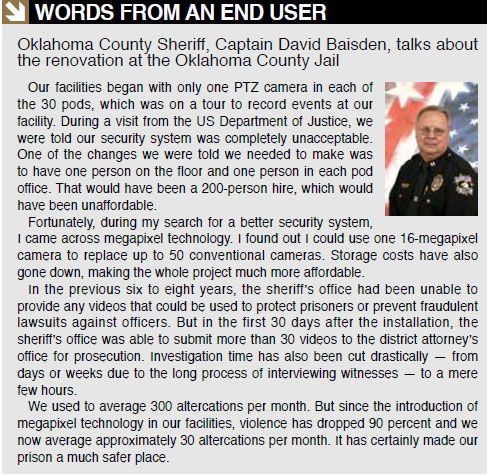Although funding is an issue, correctional facilities are deploying advanced technology to keep better watch on inmates. Everything from biometric to infrared technology is used to keep danger from entering or leaving the facility.
Although funding is an issue, correctional facilities are deploying advanced technology to keep better watch on inmates. Everything from biometric to infrared technology is used to keep danger from entering or leaving the facility.
As prisons become more crowded, more internal problems will arise. “The physical security design plays an important role in the prison security system,” said Nafis Jasmani, Sales Manager for ASEAN at Axis Communications. “Prison bureaus and authorities are continuously looking into implementing more advanced technology to ensure good security in keeping things smooth inside and outside the perimeters.”
A number of systems are put in place to secure the premises. “Obviously there is surveillance,” said Johnny Trivitayakhun, MD of Semple Cochrane. “Perimeter systems may include an electric fence for the outer layer and a tough wire fence for the inner layer. Access control is needed for all entrances and gates — down to the individual cells. Then there are the public address equipment, metal detectors, X-ray machines and so forth. Road blockers are also used for the main entrance because there have been incidents where inmates would try to escape by hijacking a car and running it through the gates.”
Biometrics is playing a key role in highly integrated prison facilities, from access control and record keeping, to tracking the movement of inmates. “Most jails have an electronic automated fingerprint identification system (AFIS), where the fingerprints captured during the time of arrest and incarceration are stored,” said Michael Trader, President of M2SYS.“Some facilities send a copy to the agency maintaining the statewide AFIS and also to the FBI, which maintains a national integrated AFIS fingerprint and criminal history system. Some still use ink and paper to capture the fingerprints onto cards, which are then mailed in; however, it could take weeks to receive results. For those facilities using an AFIS, the entire process is done electronically and it saves a lot of time and manpower.”
Biometric information can also be used within the walls of the facility to verify inmate information. “By storing an inmate's biometric information, facilities can determine whether or not the same inmate has been incarcerated within the facility before, and if so, making duplicate copies of their records upon entry can be avoided,” Trader said.
Records can help keep track of inmates and even protect the facility from lawsuits. “By implementing biometric readers at access points, such as the library or the health services, jails can prove the inmate has been given access to these areas. There were cases where an inmate would sue the prison upon release, stating proper care was denied,” Trader said. For inmate release and other services such as the distribution of medicine, biometrics can help verify the identity of a person.
Keeping biometric records of visitors can expedite regular visits. “Jails need to regulate the people who are allowed to visit the facility,” Trader said. “Also, family members who are frequent visitors can store their biometric information in the database and avoid having to fill out the same forms every time they come in.” There are a variety of biometric modalities that are suitable for this purpose, such as fingerprint, finger/ palm vein and iris/face recognition.
 Biometrics are primarily used for identification rather than access control. “Facial recognition is widely used, although mostly for record keeping,” said Aluisio Figueiredo, COO of Intelligent Security Systems. “Fingerprint technology is sometimes used for access control because it is a more cost-effective alternative.”
Biometrics are primarily used for identification rather than access control. “Facial recognition is widely used, although mostly for record keeping,” said Aluisio Figueiredo, COO of Intelligent Security Systems. “Fingerprint technology is sometimes used for access control because it is a more cost-effective alternative.”
According to Trivitayakhun, smart cards are rarely used because they can be stolen and used as knives. “Instead, we use RFID tokens and to gain access, the user must present either the token with a PIN or a fingerprint. We would never allow only a token for access. Also, the access control device itself can be used to send an alarm by punching in a specific sequence during an emergency.”
Scanners
Scanners, such as metal detectors and X-ray machines, are largely used to prevent contraband items from entering the facility. X-ray machines have raised privacy and health concerns, which is why alternative technologies are being introduced. “Thermal booster infrared technology is new on the market and it is a combination of an infrared camera and a heat source,” said Peter Harris, CSO of ISCON Video Imaging. “They are less expensive than X-ray machines and have been proven effective in the detection of items hidden under clothing.”
 Thermal scanning can add other features such as facial recognition, explosive detection or heart-rate checks to see if users are nervous, Harris said. However, the infrared camera may have trouble detecting items a person has carried for a long time, as its temperature could be too close to body temperature.
Thermal scanning can add other features such as facial recognition, explosive detection or heart-rate checks to see if users are nervous, Harris said. However, the infrared camera may have trouble detecting items a person has carried for a long time, as its temperature could be too close to body temperature.
By using technology such as scanners, inmates and visitors will not need to be subjugated to strip searches or invasive pat-downs, which can also help deter unnecessary and false sexual harassment claims.
IP Uptake
A clear view of all corners of a facility is required in a prison, which is why megapixel and HD video sees strong demand. “Megapixel technology is capable of delivering complete awareness in all prison areas without requiring a security guard for each cell pod, which could save more than US$10 million annually,” said Rick Ramsay, Senior Product Manager, Avigilon.
The surveillance system must be able to identify people in the general surroundings and detect them when hidden. “HD provides up to five times higher resolution and twice the linear resolution compared to traditional analog,” Jasmani said. “Furthermore, it comes with wide-screen format and DVD-quality audio.”
Thermal cameras are used to detect people, objects and incidents in complete darkness. “They can pick up images even when it is obscured by smoke, haze, dust and light fog,” Jasmani said. “Also, they are immune to problems with light conditions and normal shadows, thus achieving higher accuracy than conventional cameras in most intelligent video applications.”
 Not all facilities have the money to obtain many megapixel and HD cameras and provide adequate storage. “Dedicated cameras are still widely used for corridors and critical areas, such as entrances and exits, and megapixel cameras are used for central areas where entire areas need to be taken in,” said Herve Fages, Global Marketing Director for Pelco (a Schneider Electric company).
Not all facilities have the money to obtain many megapixel and HD cameras and provide adequate storage. “Dedicated cameras are still widely used for corridors and critical areas, such as entrances and exits, and megapixel cameras are used for central areas where entire areas need to be taken in,” said Herve Fages, Global Marketing Director for Pelco (a Schneider Electric company).
Many facilities are already equipped with analog cameras and disposing all of them would be a waste. “In general, we see megapixel and HD as a rapidly expanding market as prisons use analog encoders to record existing cameras, build hybrid systems and install HD cameras over time as need and budget allows,” Ramsay said.
Wired Up
Although more network cameras are being used by the general CCTV industry, prisons in the U.K. currently prefer hard wired technology. “Fiber optics is used for transmission due to its reliability and resilience to electrical interference,” said Ron Harris, Technical Sales Manager and Senior Security Consultant, Quadrant Security. “Wireless transmission for highsecurity applications is still not fully trusted at this moment in the U.K.”
However, there are situations when wireless is required. “Keep in mind that these facilities are made of very hard concrete and sometimes it may be difficult to retrofit a system since drilling will take up too much time and effort,” Figueiredo said. “This is when wireless transmission is used. However, all the new facilities being built rely on fiber-optic transmission.”
Not all cable is made equal. “High humidity levels can ruin copper cables in three to four years,” Trivitayakhun said.“Byusin g fiber optics, costs can be cut from the constant replacement of copper cabling required to keep transmissions stable.”
 Redundancy
Redundancy
When security is of utmost importance, recording redundancy is no small matter. “Redundancy is typically achieved using failover servers,” Ramsay said. This allows for dedicated servers to be available to automatically failover or a distributed approach where all the servers have extra capacity available to manage cameras from one server if it becomes unavailable. Some high-security locations make use of redundant recording to mirror storage off-site.
Even when electricity is switched off, backup generators allow access to the system. All information is archived for a minimum of 30 days and the system has the capacity to retain 60 days of information, Trivitayakhun said. Information is saved in a secure area and can be migrated to the headquarters for viewing or storage.
However, there are facilities where there is no backup system in place. “Processes around the redundancy of the systems and hardware replication are dependant on the risk assessment established by the operators of the facility,” said Sanjeev Vanmali, Security Account Manager for South APAC, Honeywell Building Solutions. Some facilities may not provide redundancy due to budget constraints or it being deemed unnecessary
The monitoring room is usually at an isolated location that tends to be difficult, if not impossible, to be broken into. However, in some cases the monitoring is done remotely. In Portugal, there often is a central monitoring station that is responsible for several prisons, Figueiredo said.
 Other Technologies
Other Technologies
New ways to secure prison facilities are being discovered. Sound technology is used to pick up on aggression. “The system is capable of running on cameras and video recorder systems where it analyses sound input to provide real-time alerts,” said Chris Mitchell, founder and CEO of Audio Analytic. “The system has been trained on hundreds of examples of people becoming aggressive and these sound packs can be used to identify dangerous situations as soon as they occur. Also, it is important to note that the system does not necessarily allow the operator to hear any sound in the control center.”
Future
The implementation of digital technology is improving in recent projects to almost 50 percent, according to Vanmali. New products are relying on digital technology and it is important to find ways to convert technologies from the analog world to the digital formats. “There are limitations that exist with older facilities and their lack of network infrastructure,” said Tom Coxford, Sales Manager for Canada, Senstar.
One way to prolong a system's lifespan is to use open platforms. “Using open technology standards enable easy integration and scalability,” Jasmani said.
New command and control centers that can operate multiple systems from various manufacturers will be expected in the future, said Arlene Perdomo, Marketing Coordinator, Safeguards Technology.
Open video systems — combined with the benefits of networking, digital imaging and camera intelligence — constitute an effective means of security surveillance and remote monitoring. “Live views and recordings of incidents can be both local and remotely located to ensure that at no time is information being compromised,” Jasmani said. “The high availability of the system provides comfort to the authorities, such that should anything happen in the correction facility, they have information in their hands at all times.”
In terms of detection, many companies are working on stand-off recognition, where a camera can see right away if they are attempting to smuggle in an item under their clothing. “This way unnecessary touching can be avoided,” Harris of ISCON said.
A fully integrated system will be the way of the future. “One system will be able to control everything — from the doors to the elevators — making the facility as secure as possible,” Trivitayakhun said. “Wardens would be able to guide their colleagues in the event of a critical incident and time settings can be set to lock doors or play prerecorded audio clips. Even the lights and TVs can be turned on and off by the command center.” By having full control of the facility, regulating inmates will become safer and more secure.
